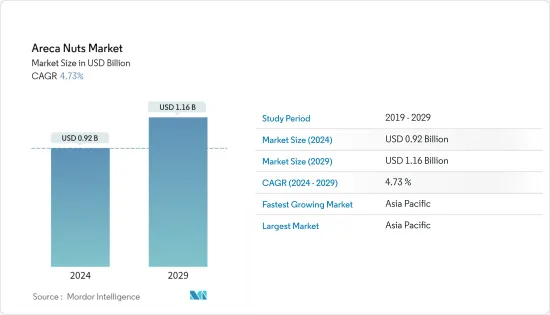 |
市場調査レポート
商品コード
1440108
ビンロウジ:市場シェア分析、業界動向と統計、成長予測(2024-2029)Areca Nuts - Market Share Analysis, Industry Trends & Statistics, Growth Forecasts (2024 - 2029) |
||||||
● お客様のご希望に応じて、既存データの加工や未掲載情報(例:国別セグメント)の追加などの対応が可能です。 詳細はお問い合わせください。
| ビンロウジ:市場シェア分析、業界動向と統計、成長予測(2024-2029) |
|
出版日: 2024年02月15日
発行: Mordor Intelligence
ページ情報: 英文 75 Pages
納期: 2~3営業日
|
- 全表示
- 概要
- 目次
ビンロウジ市場規模は、2024年に9億2,000万米ドルと推定され、2029年までに11億6,000万米ドルに達すると予測されており、予測期間(2024年から2029年)中に4.73%のCAGRで成長します。

主なハイライト
- 東南アジアでは、ビンロウジュは人気のある市販の果物です。市場では赤と白の2種類が販売されています。白いビンロウジュは成熟したナッツから作られ、赤いビンロウジュは緑色のビンロウジュの実から作られます。ビンロウジには、多糖類、ポリフェノール、タンパク質、繊維が含まれています。
- FAOSTATによると、ビンロウジの主な生産国には、インド、バングラデシュ、ミャンマー、インドネシア、中国、台湾、スリランカ、タイ、ネパールが含まれます。なお、ビンロウジの主な輸入国は、タイ、バングラデシュ、ベトナム、インド、シンガポール、中国です。 ITCトレードマップが公開したデータベースによると、2021年の世界のビンロウジの主要輸出国はインドネシア、タイ、ミャンマー、シンガポール、スリランカ、インドだった。
- スリランカ、ネパール、アラブ首長国連邦、メキシコ、タイ、シンガポールなどの国々で、パン、香り付きスーパリ、パンマサラなどのアレカ製品の需要が増え続けており、ビンロウジ市場の成長を推進しています。ビンロウジの生産の大部分は南アジア、特にインドに集中すると思われます。ビンロウジの成長には、気象条件、消費者産業の成長、消費者産業に対する政府の規則に依存するなど、厳しい制限があります。ビンロウジを継続的に摂取すると、口腔がんや喉がんなどの病気が発生します。
- ビンロウジュの摂取により数人が感染したため、インド政府およびその他の政府はビンロウジュの生産および消費産業に対してさまざまな規制を課しています。さらに、人々の健康とフィットネスに対する意識の高まりにより、ビンロウジの摂取に対する懸念が高まっており、その結果、成長に大きな障害となっています。
ビンロウジ市場動向
インドからの輸入増加
インドでは、伝統的な習慣での使用やさまざまな形での消費により、ビンロウジュの需要が高まっています。さまざまな風味を持つビンロウジの葉にこれらのナッツを使用することで、国内のビンロウジュ市場が拡大しています。生、乾燥、焼き、茹で、焙煎、塩漬けなど、さまざまな形で利用されます。皮を剥いだビンロウジは、生または加工された形で、通常はタバコと一緒に使用されます。これらは、グトカやパンマサラなど、さまざまな工業製品にも主に使用されています。これらの要因により、インドの輸入がさらに増加すると予想されます。
2021年、ビンロウジに影響を与えるさまざまな病気による生産量の急激な減少により、柔らかいビンロウジの価格は史上最高値に達しました。ビンロウジは、大雨により果腐病、芽腐れ病、黄葉病などのさまざまな病気にかかりやすいです。収量の低下と市場、特にカルナータカ州での製品に対する膨大な需要による商品の入荷不足が、作物価格の突然の高騰の主な理由でした。したがって、これらすべての要因に、病気の影響による国内生産の減少と着実に増加する需要が加わり、この商品の輸入増加につながりました。
アジア太平洋が市場を独占
ビンロウジ市場の成長は主に、アジア太平洋の先進国と新興諸国の両方でナッツの消費量が増加していることによるものです。アジア太平洋地域はビンロウジ市場の約90%を占めています。インドは世界最大のビンロウジの生産国であり、世界最大の消費国でもあります。ビンロウジュの需要のほぼすべては、インド、バングラデシュ、インドネシア、タイ、スリランカ、ミャンマーで満たされています。
しかし、ビンロウジュの一人当たりの消費量はミャンマーが多く、バングラデシュ、インド、インドネシア、中国がそれに続く。さまざまな加工食品におけるこれらのナッツの消費が増加し続けるため、消費量は近い将来さらに増加すると予想されます。
健康への危険にもかかわらず、ビンロウジ産業は活況を呈しています。この州では、ビンロウジが文化構造に深く根付いています。しかし、中国は2021年、発がんリスクを理由に、ビンロウジュの中毒性のある種であるビンロウジのテレビ、ラジオ、オンライン番組での宣伝を禁止しました。
その他の特典
- エクセル形式の市場予測(ME)シート
- 3か月のアナリストサポート
目次
第1章 イントロダクション
- 調査の前提条件と市場の定義
- 調査範囲
第2章 調査手法
第3章 エグゼクティブサマリー
第4章 市場力学
- 市場概要
- 市場促進要因
- 市場抑制要因
- バリューチェーン/サプライチェーン分析
第5章 市場セグメンテーション
- 地域別(数量別生産分析、数量および金額別消費分析、数量および金額別輸入分析、数量および金額別輸出分析、および価格動向分析)
- 北米
- 米国
- カナダ
- メキシコ
- 欧州
- ドイツ
- 英国
- スペイン
- イタリア
- アジア太平洋
- 中国
- インド
- インドネシア
- ミャンマー
- 南米
- チリ
- ブラジル
- アフリカ
- 南アフリカ
- 北米
第6章 市場機会と将来の動向
The Areca Nuts Market size is estimated at USD 0.92 billion in 2024, and is expected to reach USD 1.16 billion by 2029, growing at a CAGR of 4.73% during the forecast period (2024-2029).

Key Highlights
- In Southeast Asia, the areca nut is a popular commercial fruit. They are available in two varieties in the market - red and white. White areca nut is made from mature nuts, while red areca nut is made from green areca nuts. Areca nuts contain polysaccharides, polyphenols, proteins, and fiber.
- According to FAOSTAT, the major producers of areca nuts include India, Bangladesh, Myanmar, Indonesia, China, Taiwan, Sri Lanka, Thailand, and Nepal. Furthermore, the major importing countries of areca nuts are Thailand, Bangladesh, Vietnam, India, Singapore, and China. Indonesia, Thailand, Myanmar, Singapore, Sri Lanka, and India were some of the major exporters of areca nuts globally in 2021, as per a database published by ITC Trade map.
- The ever-growing demand for areca products, such as pan, scented supari, and pan masala in countries like Sri Lanka, Nepal, the United Arab Emirates, Mexico, Thailand, and Singapore drives the growth of the areca nut market. The majority of areca nut production is likely to be concentrated in South Asia, especially India. Areca nut has severe limitations to growth which include being dependent on the weather conditions, growth of the consumer industries, and government rules for consumer industries. The consistent consumption of areca nut causes diseases that include oral and throat cancer.
- Due to several people having been infected by the consumption of areca nut, the government of India and various other governments have posed various regulations over the areca nut production and consumer industries. Furthermore, the increasing awareness of health and fitness amongst people has raised concerns over areca nut consumption, thus, resulting in a major obstacle to growth.
Areca Nuts Market Trends
Increasing Imports from India
The demand for areca nuts is rising in India due to their usage in traditional customs and consumption in various forms. The usage of these nuts in betel leaves with different flavors is enhancing the market for areca nuts in the country. They are used in various forms, including fresh, dried, baked, boiled, roasted, and cured. Dehusked areca nuts are used in a raw or processed form, generally with tobacco. These are also majorly used in different industrially manufactured products, such as gutka and pan masala. These factors are further expected to increase the imports of India.
In 2021, the price of tender areca nuts reached an all-time high due to a sharp decline in production caused by various diseases affecting areca nut palms. Areca nut palms are susceptible to various diseases, such as fruit rot disease, bud rot, and yellow leaf disease due to the heavy rain. The shortage in the arrival of the commodity, owing to a decline in yield and the huge demand for the product in the market, especially in Karnataka, was the major reason for the sudden spurt in the price of the crop. Therefore, all these factors, coupled with reduced domestic production affected by diseases and the steadily growing demand, led to increased imports of the commodity.
Asia-Pacific Dominates the Market
The growth of the areca nuts market is mainly due to the rising consumption of nuts in both developed and developing countries of Asia-Pacific. The Asia-Pacific region holds about 90% of the market for areca nuts. India is the largest producer and the biggest consumer of areca nuts in the world. Almost all the demand for areca nuts is met by India, Bangladesh, Indonesia, Thailand, Sri Lanka, and Myanmar.
However, the per capita consumption of areca nuts is high in Myanmar, followed by Bangladesh, India, Indonesia, and China. The consumption is further expected to increase in the near future as the consumption of these nuts in different processed foods continues to increase.
Despite the danger to health, the betel-nut industry is booming. In the province, betel nuts are deeply ingrained into the cultural fabric. However, in 2021, China banned the promotion of betel nuts, the addictive seeds of areca palm trees, on television, radio, and online programs because of their cancer-causing risks.
Additional Benefits:
- The market estimate (ME) sheet in Excel format
- 3 months of analyst support
TABLE OF CONTENTS
1 INTRODUCTION
- 1.1 Study Assumptions and Market Definition
- 1.2 Scope of the Study
2 RESEARCH METHODOLOGY
3 EXECUTIVE SUMMARY
4 MARKET DYNAMICS
- 4.1 Market Overview
- 4.2 Market Drivers
- 4.3 Market Restraints
- 4.4 Value Chain/Supply Chain Analysis
5 MARKET SEGMENTATION
- 5.1 By Geography (Production Analysis by Volume, Consumption Analysis by Volume and Value, Import Analysis by Volume and Value, Export Analysis by Volume and Value, and Price Trend Analysis)
- 5.1.1 North America
- 5.1.1.1 United States
- 5.1.1.2 Canada
- 5.1.1.3 Mexico
- 5.1.2 Europe
- 5.1.2.1 Germany
- 5.1.2.2 United Kingdom
- 5.1.2.3 Spain
- 5.1.2.4 Italy
- 5.1.3 Asia-Pacific
- 5.1.3.1 China
- 5.1.3.2 India
- 5.1.3.3 Indonesia
- 5.1.3.4 Myanmar
- 5.1.4 South America
- 5.1.4.1 Chile
- 5.1.4.2 Brazil
- 5.1.5 Africa
- 5.1.5.1 South Africa
- 5.1.1 North America
